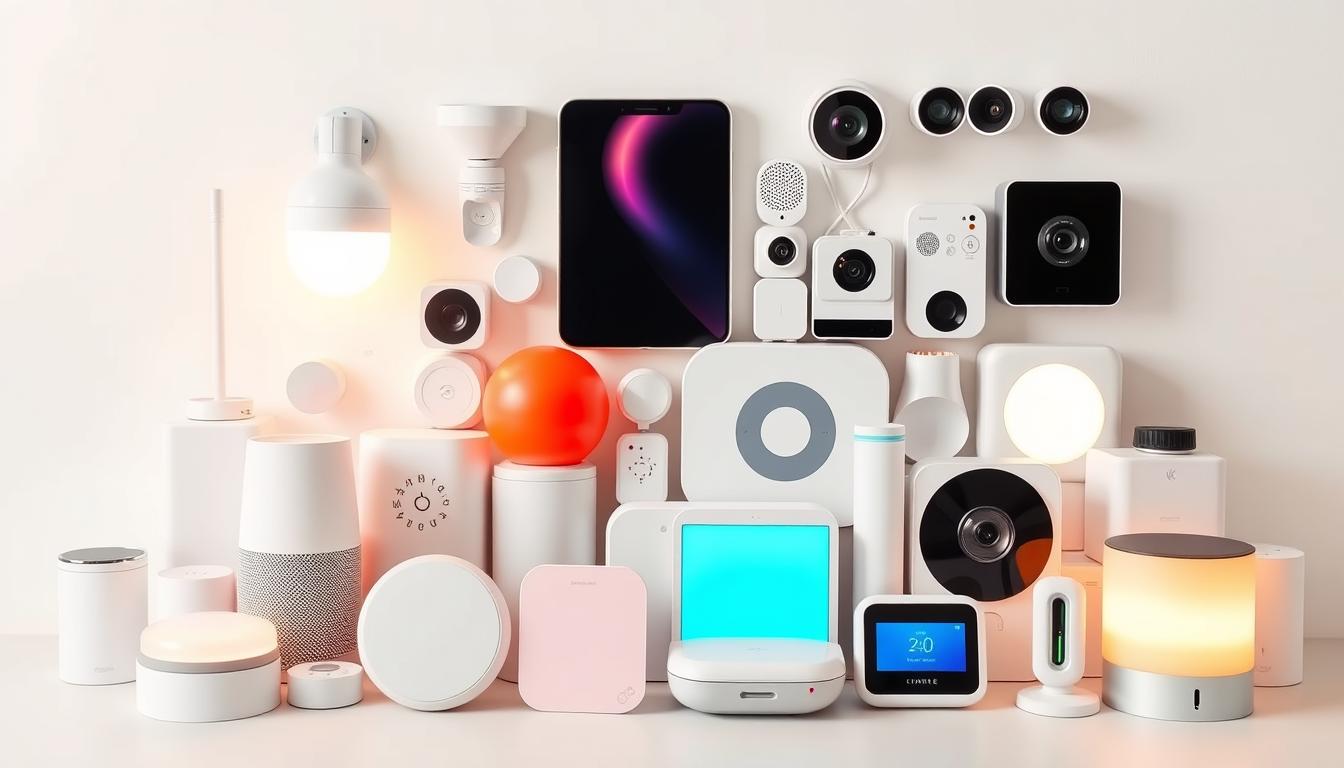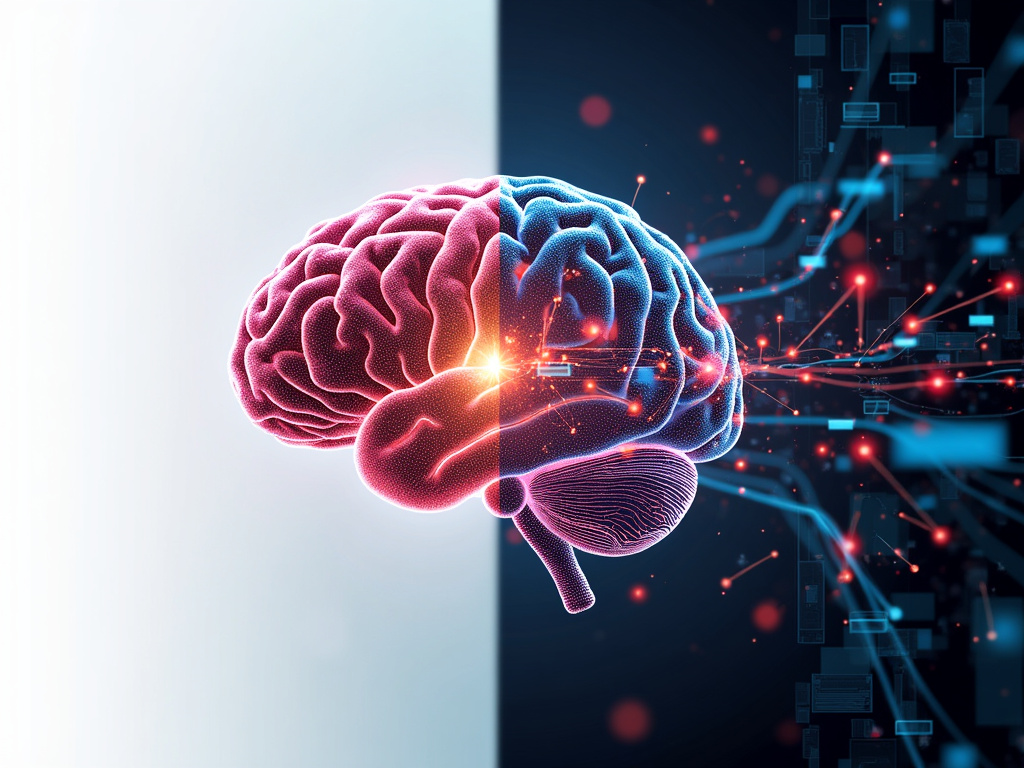Imagine waking up to a connected home that adjusts to your needs. With smart home solutions, your living space can be automated. This makes your life more comfortable, secure, and efficient. You can control many parts of your life with home automation and iot devices. This includes lighting, temperature, and security systems. A connected life is now easier than ever. Exploring smart living brings many benefits. This article will show you how to make your life more connected and efficient. Key Takeaways Understand the concept of a connected life with smart home solutions. Learn how home automation can simplify your daily tasks. Discover the role of iot devices in enhancing your living experience. Explore the benefits of integrating technology into your home. Find out how to create a more efficient and secure living space. The Evolution of Smart Home Technology Smart home tech has grown a lot. It started with simple automation and now it’s complex. You can control lights, temperature, security, and entertainment with your phone or voice. From Science Fiction to Reality Smart homes were once just a dream. But now, thanks to IoT (Internet of Things), they’re real. Devices talk to each other, making life easier for homeowners. Some big changes include: Voice assistants like Amazon Alexa and Google Assistant Smart thermostats that learn your temperature likes Automated lights that change with the day Advanced security systems that watch your home Key Milestones in Home Automation The journey of home automation has hit many big points. From the first smart devices to full smart home systems. Key moments include: The first smart thermostats came out Smart lights that you can control from afar Security cameras and smart doorbells with video These changes have made our homes better. They’re more comfy, safe, and save energy. What Is a Smart Home? A smart home is a place where everything works together. It uses technology to make your home more comfortable, safe, and efficient. This makes your life easier every day. Core Components of a Connected Home A connected home, or smart home, has key parts to work well. These include IoT devices, a strong IoT platform, and a central hub. IoT devices are things like smart thermostats and security cameras. “The beauty of a smart home lies in its ability to learn and adapt to your preferences over time,” says an expert in home automation. These devices talk to each other and the central hub. This lets you have a living experience that’s just for you. For example, your smart home can change the lights and temperature based on what you’re doing. The Role of IoT in Modern Living The Internet of Things (IoT) is key in modern homes, especially smart homes. IoT devices and platforms connect your home’s appliances and systems. This lets you control and watch them from anywhere. This makes your home more convenient, saves energy, and keeps it safe. With IoT, you can manage your home’s systems from one place. This includes changing the thermostat or turning on lights. As technology gets better, IoT’s role in making homes connected and smart grows. This is very important for our living spaces today. Benefits of Creating a Smart Home Smart home devices make living easier, safer, and more energy-efficient. They integrate technology to automate your home. This makes life more convenient and fun. Convenience and Time Savings Smart homes let you control lights, temperature, and entertainment from anywhere. This saves time and makes life better. Enhanced Security and Safety Home security is a big plus of smart homes. You can watch your home with smart doorbells, cameras, and locks. This gives you peace of mind, no matter where you are. Energy Efficiency and Cost Reduction Smart homes save energy by adjusting heating, cooling, and lights. This cuts down your bills and helps the planet. Accessibility and Aging in Place Smart homes are great for people with mobility issues or aging in place. They offer voice control and automated systems. This makes daily tasks easier and keeps independence. Benefit Description Example Convenience Control over various home systems Remote lighting control Security Enhanced monitoring and control Smart doorbells and cameras Energy Efficiency Optimized energy consumption Smart thermostats Accessibility Ease of use for all ages Voice-controlled systems Essential Smart Home Hubs and Controllers In the world of smart homes, hubs and controllers are key. They make sure all devices work together. A smart home hub or controller is like a central command center. It connects and manages smart devices, letting them talk to each other and be controlled from one place. Popular Smart Home Platforms Many smart home platforms are popular because they are easy to use and work well with different devices. They support various technologies, making it simple to add new devices. Wi-Fi Based Systems Wi-Fi based smart home systems are common because they are easy to set up and work with many devices. They use your home’s Wi-Fi, so you don’t need a separate hub in some cases. Z-Wave and Zigbee Technologies Z-Wave and Zigbee are wireless protocols used in smart home devices. They use little power, send data securely, and help devices connect better, making your network stronger. Matter Protocol and Compatibility The Matter protocol is a new standard that makes smart home devices from different brands work better together. It makes setting up your smart home easier and lets you mix devices from different brands. Choosing the Right Hub for Your Needs Choosing the right smart home hub or controller depends on a few things. These include the devices you want to connect, your budget, and how much automation you want. Here are some things to think about: Device compatibility: Make sure the hub works with your devices. Ease of use: Pick a hub with an easy-to-use interface and app. Automation capabilities: Look for a hub that lets you create complex routines and scenes. Expandability: Choose a hub that can grow with your smart home. By thinking about these things, you can find a
10 Everyday Problems AI Can Solve for you Today
Every day, I face challenges that can be frustrating and take up a lot of time. But, thanks to artificial intelligence, many of these problems can be solved quickly. The use of tech and applications in our daily lives has made things easier. It helps with everything from better digital communication to making our homes more efficient. It also helps in keeping an eye on our health. Artificial intelligence solutions bring many benefits to our lives. Key Takeaways Artificial intelligence can simplify digital communication. AI-powered applications can enhance home life. Health monitoring can be improved with AI-driven tech. Productivity can be increased with AI solutions. Daily tasks can be streamlined with artificial intelligence. The AI Revolution in Our Daily Lives The AI revolution is changing our daily lives in amazing ways. What was once science fiction is now real in our digital workplace. AI makes tasks easier and boosts productivity. From Science Fiction to Your Digital Workplace AI has moved from being a dream to a real tool in enterprise platforms and industries. It automates tasks and offers advanced consulting services. This change has made businesses more flexible and quick to adapt. Why AI Solutions Matter for the Average Person AI solutions are great for everyone, not just big companies. They simplify daily tasks, help make better decisions, and increase productivity. Some key benefits include: Increased efficiency in managing daily tasks Improved decision-making through data analysis Enhanced productivity in both personal and professional settings Streamlining Your Digital Communication with AI Digital communication is vital in our daily lives, both at work and home. It can be overwhelming, but AI offers a solution. It helps us stay productive and efficient in today’s fast world. Email Overload and Response Management Dealing with emails can be tough, especially when you get a lot every day. AI can sort emails for you. It even suggests smart replies to make responding easier. How to Set Up AI Email Filters and Smart Replies To start using AI email filters, follow these steps: Identify your most common email categories Use cloud-based email services that offer AI-driven filtering Train your email filter by marking emails as important or not Meeting Inefficiency and Note-Taking Meetings are key in the workplace. AI can improve how we handle them. It makes meetings more efficient and note-taking more accurate. Step-by-Step Guide to AI Meeting Assistants To use AI meeting assistants, do the following: Choose a meeting assistant tool that works with your calendar Set up the tool to record and transcribe meetings Use the tool’s analytics to summarize key points and action items, using data & analytics By using AI for email and meetings, you can save a lot of time. This means you can be more productive. AI Solution Benefit Implementation Step AI Email Filters Reduces email overload Train your email filter AI Meeting Assistants Enhances meeting efficiency Integrate with your calendar 10 Everyday Problems AI Can Solve for you Today AI technology helps us tackle everyday challenges better. We’ll see how it improves time management and reduces information overload. Time Management and Scheduling Conflicts Time management is key in today’s fast world. AI makes scheduling easier and lessens conflicts. Implementing AI Calendar Management Tools AI tools manage your calendar well. They plan meetings and avoid scheduling problems. They look at your schedule, likes, and needs to find the best times. Key benefits of AI calendar management include: Automated scheduling Conflict resolution Time optimization Information Overload in the Digital Age The digital world has flooded us with info. It’s hard to know what’s really important. Using AI to Filter and Prioritize Important Information AI sorts and highlights important info. It looks at what you like and do to show you what matters most. Reduced information overload Improved focus on key information Enhanced productivity Enhancing Your Home Life with Smart AI Solutions Smart AI solutions have made our homes more convenient and energy-efficient. They help us automate tasks, save energy, and make our homes more comfortable. Home Energy Waste and Management Smart AI solutions are great at managing home energy waste. AI-powered energy management systems analyze how we use energy. They then suggest ways to cut down on waste, saving us money and reducing carbon emissions. Setting Up Smart Home AI Systems for Energy Efficiency To make your home energy-efficient, start with smart thermostats and lighting systems. These can be controlled from your phone or tablet. They learn your habits to use energy wisely. Repetitive Household Tasks AI can also automate boring household tasks. From robotic vacuum cleaners to smart home assistants, AI devices can clean, schedule, and even shop for groceries. Automating Your Home with Voice Commands and Routines Using voice commands and routines makes controlling your home easy. You can turn lights on, play music, or change the temperature with just a voice command. Setting up routines lets you do many tasks with one command, making life easier. By using these smart AI solutions, homeowners can enjoy a more efficient and convenient life. They make the most of new tech and hybrid infrastructure. AI-Powered Health and Wellness Monitoring Exploring artificial intelligence shows how it boosts my health and wellness. AI tools give me personalized advice and insights. This helps me manage my health better. Tracking Health Metrics and Habits AI health apps track my health, like heart rate and sleep. They offer personalized recommendations to better my health. Managing Stress and Mental Wellbeing Stress and mental health are key to overall health. AI tools help with meditation and mindfulness. They reduce stress and clear my mind. How to Use AI Health Apps for Personalized Recommendations To use AI health apps well, I must use them often and give accurate data. This way, I get advice on improving my health. Implementing AI Tools for Meditation and Mindfulness AI meditation tools help me practice regularly. They reduce stress and improve my mental health. These tools guide me and track my progress. Using AI-powered health and wellness monitoring helps me take charge
What AI Agent can do: Discover the Capabilities of an AI Agent
I’ve seen a big change in AI agents over the years. They’ve moved from simple chatbots to smart helpers that can do complex tasks. By 2025, AI automation will be a big part of our lives. It will help with things like setting up appointments and booking travel. Big tech companies like Google and OpenAI are making AI agents that can understand what we mean and do hard tasks. This is changing how we use technology. Tools like Zapier and other automation platforms let us connect different services and automate tasks easily. This shows the idea of no-code automation. Key Takeaways AI agents have evolved significantly, becoming more sophisticated. They assist with a variety of daily tasks. Major tech companies are developing advanced AI agents. Automation platforms enable easy integration and workflow automation. No-code automation is making technology more accessible. The Evolution of AI Agents Through 2025 AI agents have seen huge growth by 2025, changing how they work. A big leap is in natural language processing (NLP). Now, AI agents can understand and talk human language better. Natural Language Processing Advancements NLP has improved a lot. AI agents can now handle complex questions and answer them right. This is thanks to advanced algorithms and learning from big data. AI agents also get better at understanding the context. They can now get the point of a conversation or task. This makes their answers more helpful and relevant. It’s especially good for app integrations. These changes have made AI agents smarter and more helpful. They are now a big part of our daily lives and many industries. What AI Agents Can Do: Breaking Down Their 2025 Capabilities In 2025, AI agents will be more than just tools. They will become personalized assistants that learn and adapt to our needs. This change is thanks to new personalization features and continuous improvement systems. Personalization Features AI agents in 2025 will offer experiences tailored just for you. They’ll learn your preferences and adjust their responses and suggestions. This is made possible by advanced algorithms that study your behavior and feedback. For example, AI-powered virtual assistants can handle daily tasks better. They can automate tasks like scheduling appointments and sending reminders. This is based on your habits and what you like. AI agents in 2025 will also keep getting better. They use AI automation and machine learning to improve over time. They learn from interactions and adapt to new info, making their outputs more accurate and relevant. This improvement is also helped by zaps or integrations with other apps and services. This lets AI agents access more data and functions. So, they can offer better support and help increase user productivity. With these abilities, AI agents are poised to change how we work and live. 2025 will be a key year for AI technology adoption and integration. Major AI Agents Dominating the 2025 Market In 2025, a few big names will lead the AI world. Google, OpenAI, and Amazon are at the top. They offer cutting-edge AI solutions that are changing many industries. These major AI agents have special features. Google’s AI works well with Google services, making things smooth. OpenAI’s AI is great at understanding and creating language. Comparative Performance Metrics When we look at how these AI agents perform, we see several key areas. Zapier’s no-code automation platform is unique because it works with over 7,000+ apps. This makes it very useful for businesses. Google’s AI agents are top in data analysis and prediction. OpenAI’s agents lead in natural language processing. Amazon’s AI solutions are known for their use in customer service. The performance of these AI agents shows how fast AI technology is growing. As the market keeps changing, it will be exciting to see how these leaders evolve and improve. How AI Agents Are Revolutionizing Daily Life in 2025 AI agents are changing how we live and work in 2025. They bring convenience and boost productivity. These smart systems are key to our daily lives, making tasks easier and improving our quality of life. I’ve seen AI agents automate tasks like scheduling and managing shopping lists. For example, virtual assistants like Amazon’s Alexa and Google Assistant can control smart home devices. They also set reminders and make online purchases. Real-World Success Stories Many success stories show AI agents’ impact. AI chatbots help customer service teams work around the clock. This leads to faster responses and happier customers. In healthcare, AI agents monitor patient data and predict health issues. They help personalize treatment plans. This improves patient care and reduces healthcare worker stress. The future of AI agents looks bright. They could help in education, finance, and transportation. As AI grows, we’ll see more ways to make our lives easier and more efficient. The main benefits of AI agents are better productivity, convenience, and decision-making. As we progress, using AI agents wisely is crucial. We must ensure they are developed and used responsibly. Zapier’s AI Agent Innovations: The 2025 Breakthrough Zapier is changing how we work with its AI agent innovations. As someone who’s watched Zapier grow, I see how these changes are making a big difference. Zapier’s AI agents make work easier and more efficient for businesses. They handle the boring tasks so teams can focus on big ideas. Enterprise Implementation Case Studies Many big companies have tried Zapier’s AI agents and seen great results. For example, a top marketing firm got 30% more done with Zapier’s help. Improved workflow automation Enhanced team collaboration Significant productivity gains These stories show how Zapier’s AI agents can help businesses grow and work better. With these tools, companies can stay on top in a fast-changing world. Looking into AI agents, it’s clear Zapier is leading the way in work’s future. Privacy and Ethical Considerations in the AI Agent Era The rise of AI agents has brought up big questions. How do we keep user data safe and make sure AI is used ethically? Data privacy is a big worry. AI agents need lots
Is AI Dangerous?
It feels like every time I open my phone or read the news, there’s a new story about AI. From self-driving cars to virtual assistants like Alexa and Siri, AI is everywhere. But with all this hype, there’s one question that never seems to go away: Is AI dangerous? It’s a fair question. Let’s break it down together. So, What Exactly Is AI? Okay, before we proceed further, let’s clear up what we actually mean by “AI.” When you hear the term, it can feel kind of intimidating—like something out of a sci-fi movie, right? But here’s the thing: AI is just a really smart tool. It’s computer software designed to handle tasks that usually require human intelligence. Think about your phone suggesting the best route home or your Netflix queue serving up the perfect show—it’s all AI. In the simplest terms, AI can: Sounds pretty cool, right? But don’t let the futuristic vibes fool you—AI is just a tool. And like any tool, it’s all about how we choose to use it. So, Is AI Dangerous? Let’s Get Real Now, here’s the million-dollar question: Is AI dangerous? Short answer? Not really. But it depends on how we handle it. Let’s bust a few myths. AI Doesn’t Have Feelings or IntentIf you’ve ever worried about AI waking up one day and deciding to take over the world—rest easy. AI doesn’t have feelings, goals, or aspirations. It’s not sitting there, plotting your demise. Seriously, it’s not like Alexa is secretly planning a robot uprising. In reality, AI just does what it’s programmed to do. It’s all about the data and code behind it, nothing more. So, the idea that AI might develop some kind of evil agenda? That’s pure science fiction. We’re not living in Terminator, people. AI Is Just Another ToolThink of AI like a hammer. It’s super useful when you need to build something, but it’s not going to build a house on its own. In the same way, AI is great for tasks like improving traffic systems or helping doctors catch diseases early. But like any tool, it can be used poorly if people aren’t careful. This is why there’s such a big push to regulate AI—to make sure it’s used ethically and responsibly. AI Isn’t All-PowerfulAnother big misconception is that AI can do everything. People hear about all the amazing things AI can do, and they start thinking it’s some kind of all-knowing, all-seeing oracle. Spoiler alert: it’s not. Sure, AI is great at processing huge amounts of data quickly and recognizing patterns, but it’s only as good as the information it’s given. If the data is biased or flawed, guess what? The AI will be biased or flawed, too. It’s not perfect, and it still relies on humans to guide it. What Should We Really Be Worried About? When people think about the dangers of AI, they often picture scenes from sci-fi movies—robots taking over the world or machines becoming too smart for their own good. While these scenarios are far from reality, just because AI isn’t about to turn into Skynet doesn’t mean we shouldn’t think carefully about how we use it. There are real concerns that we need to address. Wait! AI Isn’t All Bad While it’s smart to be cautious, AI also brings a lot of positive changes to the world: So, What’s the conclusion? Is AI Dangerous? The short answer is: it can be, but it doesn’t have to be. Like any powerful tool, AI’s impact depends on how we choose to use it. If we ensure that AI is developed responsibly—addressing ethical concerns, protecting privacy, and being mindful of its influence on jobs—we can harness its potential for good. At the end, it’s about balance. AI is a tool that, when used thoughtfully and ethically, can improve our lives in amazing ways. But we must remain vigilant, ensuring that as it evolves, it does so in a way that benefits everyone. The future is in our hands!
What’s the difference between AI and Machine Learning?
Nowadays, many people refer to the terms Artificial Intelligence and Machine Learning. Both are amongst the hot technologies, although people generally use these terms interchangeably, they mean different things. It becomes critical to understand the difference between AI and ML to know how each shapes up the future of technology.In this article, we’ll look at what sets AI and ML apart, how they relate, and where you might already be seeing them in action in your day-to-day life. Well, what is AI?Thus, AI stands for Artificial Intelligence, which involves developing machines that think and act like humans. In other words, AI would mimic human intelligence in problem-solving, learning, and understanding of languages. It is a wide series of technologies that also includes robotics, NLP, and rule-based systems. Basically, it is the “big goal” of making machines capable of doing things that up until now only humans could do. Examples of AI in action:1. Chatbots that can have conversations and answer questions.2. Employed in independent robots performing complex tasks, for example, from factories to hospitals. And What About Machine Learning?Now, Machine Learning, in short ML, is actually a subset of AI. The important idea underlying ML is that machines can actually learn from data. As opposed to the traditional way of programming a computer, whereby you specify exactly what the computer should do, in ML algorithms, they get better and adapt as they get more experience. They get better at finding patterns and making predictions as the amount of data they work with increases. Ever notice how Netflix or Amazon just seems to instinctively know that next show you wanna watch or what product you’re gonna buy? Well, that’s ML in action. These systems learn from your behaviors-and the millions of other users-out there to make smarter recommendations the more you use them. Differences Between AI and MLAlthough they are very much related, AI and ML differ in their important aspects: Aspect AI ML Scope Broad techniques Learning from data Objective Learn to recognize patterns through human-like intelligence Predict patterns based on statistical models Data Requirement Can perform well with less data, depending on methodology Best performance with more data Human Involvement May require human setup of rules Can learn independently from minimal input The essential idea is that AI represents intelligence incorporated into machines, while ML is a process through which this intelligence extracts knowledge and improves with less human intervention. How do AI and ML relate to each other? Think of it this way: all machine learning is a form of AI, but not all AI involves machine learning. For example, your virtual assistant Siri or Alexa is a form of AI in that she understands and can respond to your voice; not everything those bots utter, however, has anything to do with ML. On the other hand, your email has strong dependence on spam filters based on lots of training data.Real-Life Examples of AI and MLYou are going to be surprised at how much already AI and ML is part of your life. Here are just a few examples: AI in action: Self-driving cars: It enables AI to process data from sensors of the car for navigating safely. Bots: Through Natural Language Understanding, AI-driven chatbots walk customers through a process of troubleshooting the problem. ML in practice: Spam Detection: ML algorithms scan through your emails for a clean inbox, totally spam-free. Predictive analytics: Companies use ML to predict future sales, inventory levels in the future, and everything else requiring historic data. Wrapping Up In other words, AI is about making machines think and act like human beings, while ML is a subset of AI in which the learning from data is emphasized. AI involves several techniques, being machine learning one of the most powerful ways to achieve it. Bringing this difference to light is a gigantic advantage for those interested in AI or ML applications in industries that range from healthcare to entertainment. Knowing when to use which opens up amazing opportunities for innovation that help develop and construct smarter and more efficient systems at our service.






